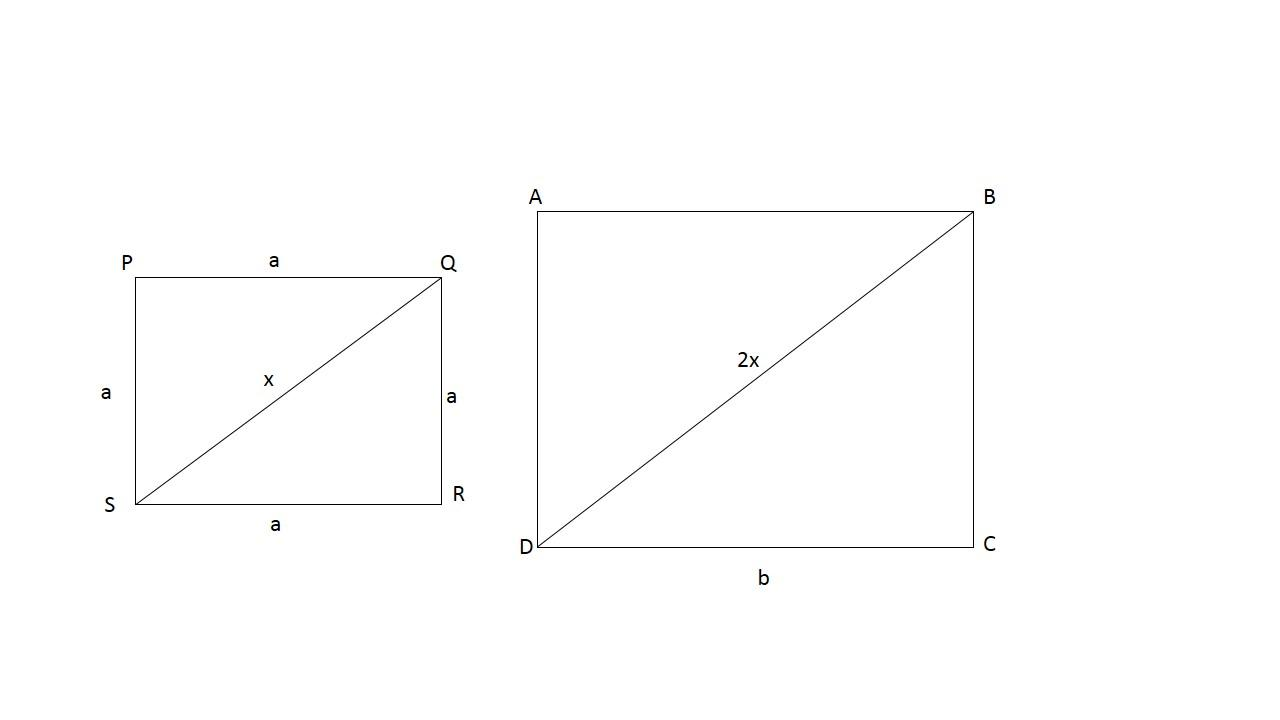
If a diagonal of a square is doubled, then the area of the square becomes m times. Find m.
Answer
578.4k+ views
Hint: Use Pythagoras theorem to find the diagonal of the square, then double it to get the new length. Use this length to compute the area of the resultant square.
Complete step by step answer:
Consider a square of side length ‘a’

Using Pythagoras theorem on $\Delta \,\text{QRS}$,
\[\begin{align}
& \text{S}{{\text{R}}^{\text{2}}}\,\text{+}\,\text{Q}{{\text{R}}^{\text{2}}}\,\text{=}\,\text{Q}{{\text{S}}^{\text{2}}} \\
& {{\text{a}}^{\text{2}}}\,\text{+}\,{{\text{a}}^{\text{2}}}\,\text{=}\,\text{Q}{{\text{S}}^{\text{2}}}
\end{align}\]
$\therefore $ length of diagonal $\text{QS}\,\text{=}\,\sqrt{\text{2}}\text{a}$
Now, according to the question, the diagonal of square
\[\begin{align}
& \text{ABCD}\,\text{=}\,\text{2 }\!\!\times\!\!\text{ }\,\text{diagonal}\,\text{of PQRS} \\
& \text{=}\,\text{2}\,\times \,\sqrt{2}a \\
& =\,2\sqrt{2}a.
\end{align}\]
Let us apply the Pythagoras theorem again on $\Delta \,\text{BCD}$
\[\text{C}{{\text{D}}^{\text{2}}}\,\text{+}\,\text{B}{{\text{C}}^{\text{2}}}\,\text{=}\,\text{BD}\]
But $\text{BD}\,\text{=}\,\text{2}\sqrt{2}\text{a}$, as derived before
\[\begin{align}
& \therefore \,\text{C}{{\text{D}}^{\text{2}}}\,\text{+}\,\text{B}{{\text{C}}^{\text{2}}}\,\text{=}\,\text{8}{{\text{a}}^{\text{2}}} \\
& \text{But}\,\text{CD}\,\text{=}\,\text{BC}\,\text{=}\,\text{b}\,\text{(New square side)} \\
& \text{2}{{\text{b}}^{2}}\,=\,8{{\text{a}}^{2}} \\
& \text{b}\,\text{=}\,\text{2a}
\end{align}\]
So the new square has a side that’s double the length of the old square.
Let’s finally compare areas
$\begin{align}
& \text{Area}\,\text{of}\,\text{PQRS}\,\text{=}\,{{\text{a}}^{\text{2}}} \\
& \text{Area}\,\text{of}\,\text{ABCD}\,\text{=}\,{{\text{b}}^{\text{2}}}\,\text{=}\,{{\text{(2a)}}^{\text{2}}}\,\text{=}\,\text{4}{{\text{a}}^{\text{2}}} \\
\end{align}$
\[\therefore \,\dfrac{\text{Area}\,\text{of}\,\text{ABCD}}{\text{Area}\,\text{of}\,\text{PQRS}}\,\text{=}\,\dfrac{\text{4}{{\text{a}}^{\text{2}}}}{{{\text{a}}^{\text{2}}}}\,\text{=}\,\text{4}\]
Hence m = 4
Note: Remember that if a square changes its length by la times, its area changes by a factor of ${{\text{l}}^{2}}$, depending on whether the length is increase or decreases.
$\begin{align}
& \text{If}\,\text{a}\,\to \,\text{la}\,\text{then}\,\text{area}\,\to \,{{\text{l}}^{\text{2}}}\,\text{area} \\
& \text{If}\,\text{a}\,\to \,\dfrac{\text{l}}{\text{l}}\text{a}\,\text{then}\,\text{area}\,\to \,\dfrac{\text{l}}{{{\text{l}}^{\text{2}}}}\,\text{area} \\
\end{align}$
Complete step by step answer:
Consider a square of side length ‘a’

Using Pythagoras theorem on $\Delta \,\text{QRS}$,
\[\begin{align}
& \text{S}{{\text{R}}^{\text{2}}}\,\text{+}\,\text{Q}{{\text{R}}^{\text{2}}}\,\text{=}\,\text{Q}{{\text{S}}^{\text{2}}} \\
& {{\text{a}}^{\text{2}}}\,\text{+}\,{{\text{a}}^{\text{2}}}\,\text{=}\,\text{Q}{{\text{S}}^{\text{2}}}
\end{align}\]
$\therefore $ length of diagonal $\text{QS}\,\text{=}\,\sqrt{\text{2}}\text{a}$
Now, according to the question, the diagonal of square
\[\begin{align}
& \text{ABCD}\,\text{=}\,\text{2 }\!\!\times\!\!\text{ }\,\text{diagonal}\,\text{of PQRS} \\
& \text{=}\,\text{2}\,\times \,\sqrt{2}a \\
& =\,2\sqrt{2}a.
\end{align}\]
Let us apply the Pythagoras theorem again on $\Delta \,\text{BCD}$
\[\text{C}{{\text{D}}^{\text{2}}}\,\text{+}\,\text{B}{{\text{C}}^{\text{2}}}\,\text{=}\,\text{BD}\]
But $\text{BD}\,\text{=}\,\text{2}\sqrt{2}\text{a}$, as derived before
\[\begin{align}
& \therefore \,\text{C}{{\text{D}}^{\text{2}}}\,\text{+}\,\text{B}{{\text{C}}^{\text{2}}}\,\text{=}\,\text{8}{{\text{a}}^{\text{2}}} \\
& \text{But}\,\text{CD}\,\text{=}\,\text{BC}\,\text{=}\,\text{b}\,\text{(New square side)} \\
& \text{2}{{\text{b}}^{2}}\,=\,8{{\text{a}}^{2}} \\
& \text{b}\,\text{=}\,\text{2a}
\end{align}\]
So the new square has a side that’s double the length of the old square.
Let’s finally compare areas
$\begin{align}
& \text{Area}\,\text{of}\,\text{PQRS}\,\text{=}\,{{\text{a}}^{\text{2}}} \\
& \text{Area}\,\text{of}\,\text{ABCD}\,\text{=}\,{{\text{b}}^{\text{2}}}\,\text{=}\,{{\text{(2a)}}^{\text{2}}}\,\text{=}\,\text{4}{{\text{a}}^{\text{2}}} \\
\end{align}$
\[\therefore \,\dfrac{\text{Area}\,\text{of}\,\text{ABCD}}{\text{Area}\,\text{of}\,\text{PQRS}}\,\text{=}\,\dfrac{\text{4}{{\text{a}}^{\text{2}}}}{{{\text{a}}^{\text{2}}}}\,\text{=}\,\text{4}\]
Hence m = 4
Note: Remember that if a square changes its length by la times, its area changes by a factor of ${{\text{l}}^{2}}$, depending on whether the length is increase or decreases.
$\begin{align}
& \text{If}\,\text{a}\,\to \,\text{la}\,\text{then}\,\text{area}\,\to \,{{\text{l}}^{\text{2}}}\,\text{area} \\
& \text{If}\,\text{a}\,\to \,\dfrac{\text{l}}{\text{l}}\text{a}\,\text{then}\,\text{area}\,\to \,\dfrac{\text{l}}{{{\text{l}}^{\text{2}}}}\,\text{area} \\
\end{align}$
Recently Updated Pages
Master Class 8 Social Science: Engaging Questions & Answers for Success

Master Class 8 Maths: Engaging Questions & Answers for Success

Master Class 8 Science: Engaging Questions & Answers for Success

Class 8 Question and Answer - Your Ultimate Solutions Guide

Master Class 8 English: Engaging Questions & Answers for Success

Why are manures considered better than fertilizers class 11 biology CBSE

Trending doubts
What is BLO What is the full form of BLO class 8 social science CBSE

Citizens of India can vote at the age of A 18 years class 8 social science CBSE

Full form of STD, ISD and PCO

Right to vote is a AFundamental Right BFundamental class 8 social science CBSE

What is the difference between rai and mustard see class 8 biology CBSE

Summary of the poem Where the Mind is Without Fear class 8 english CBSE





